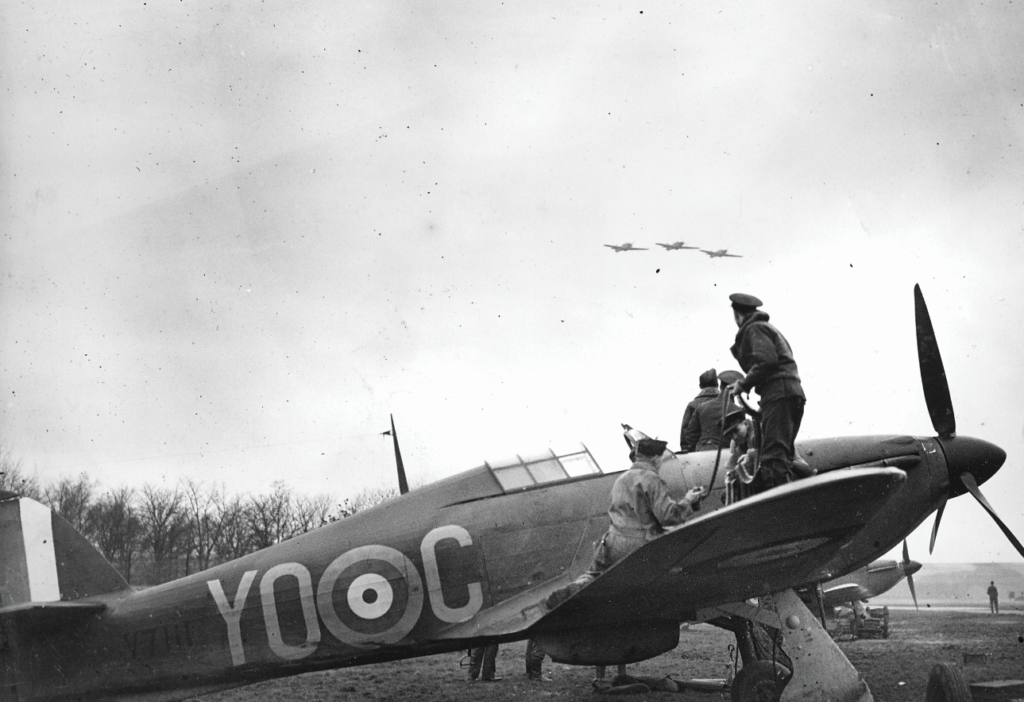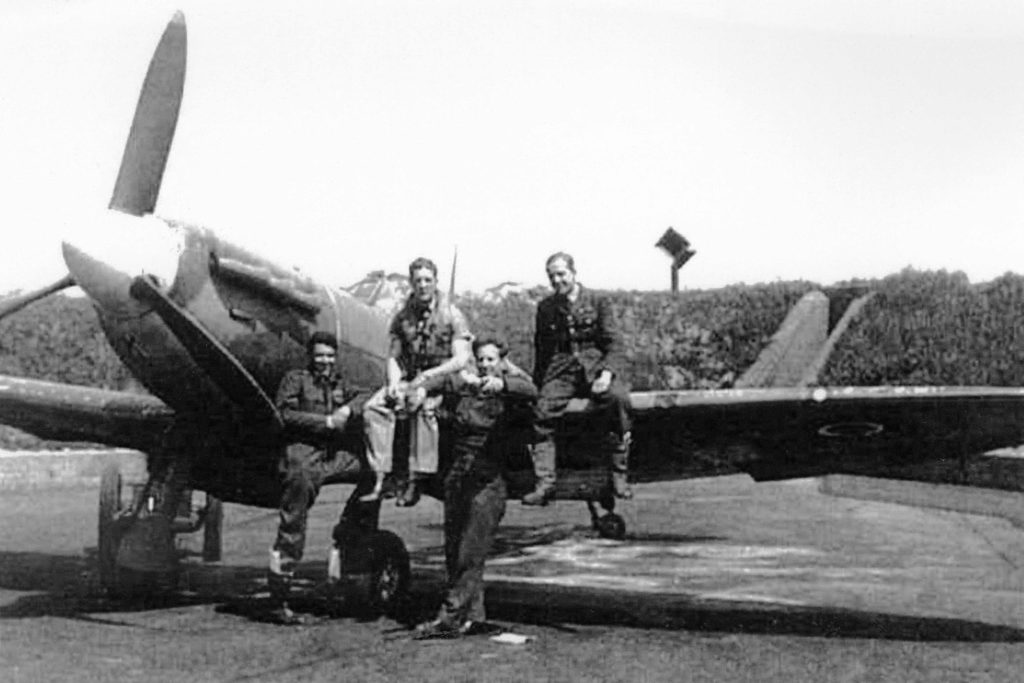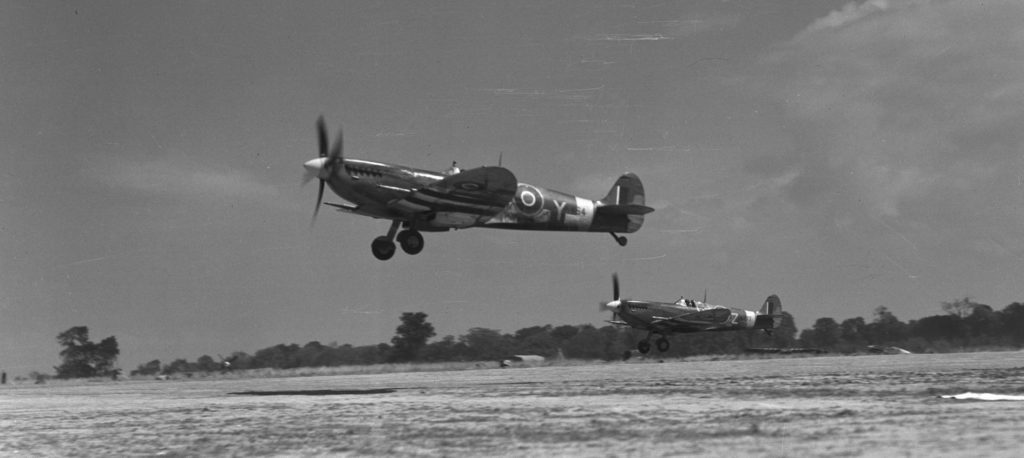Estimated reading time 15 minutes, 51 seconds.
Not many RCAF pilots can say that they flew with British ace Johnnie Johnson when he was still developing his tactical abilities (including flying as an element leader in his flight at Dieppe) or whose design for a navigation aid caught the attention of the British Air Ministry, or whose final words displayed confidence and eloquence.

PO Junius Lyman Edward Hokan was such a unique pilot.
Hokan was born and raised in St. Catharines, Ont. Service to his country must have been in his blood as his father had served in the First World War. Lyman William Hogan, as his name is spelled on the enrollment document, had enlisted in the Canadian Field Artillery on Nov. 30, 1914, and served with the 14th Battery, 4th Brigade. He arrived in France on Sept. 15, 1915, and fought in all the major battles of the Canadian Corps. He was discharged in Canada on March 27, 1919. It should have been no surprise that, at the age of 18, Junius Hokan enlisted in the Royal Canadian Air Force on Nov. 11, 1940, in Niagara Falls, Ont.
Attending No. 1 Initial Training School, Hokan learned the basics of flight and, more importantly, was assessed in the Link Trainer. Here he was able to demonstrate an aptitude for flying — if he hadn’t, he would have been relegated to being an observer (navigator). He then completed his initial pilot training at No. 9 Elementary Flying Training School in St. Catharines, followed by No. 2 Service Flying Training School at Uplands in Ottawa, where he completed his advanced pilot training.
On Aug. 8, 1941, Hokan received his pilot wings; he was also sufficiently high in standing on the course that he was commissioned as a pilot officer. Hokan received two weeks of embarkation leave and was sent to the United Kingdom.
As with most RCAF aircrew who arrived in the U.K., Hokan was transferred to the Royal Air Force on arrival at No. 3 Personnel Reception Centre as the RCAF did not have enough squadrons to accept all the aircrew the British Commonwealth Air Training Plan was producing. He went to No. 56 Operational Training Unit where he was brought up to speed on the latest air combat techniques. Then, on Feb. 18, 1942, he was posted to No. 610 Squadron — although he had arrived at the squadron several days before and been attached to “A” Flight.
Posted to 610 Squadron
No. 610 Squadron was a pre-war RAF auxiliary squadron that had fought during the Battle of Britain. When Hokan arrived, the squadron was flying the Spitfire Mk. Vb. from RAF Hutton Cranswick. Squadron leader G.S.K. Haywood was the newly-appointed commanding officer. The squadron was involved in intruder operations until April 1942, after which its new role was convoy protection and reconnaissance, operating out of RAF Ludham.
In July 1942, Squadron leader J.E. “Johnnie” Johnson assumed command of the squadron; by this time he had already been awarded the Distinguished Flying Cross and Bar. 610 Squadron was very much an international squadron with pilots from Australia, Belgium, France, Norway and Rhodesia.
By early 1942, most RAF squadrons had adopted the “finger four” formation for combat. It consisted of a flight leader (No.1) and his wingman (No. 2), an element leader (No. 3) and his wingman (No. 4). The role of the two wingmen was to protect their leader from attacks, allowing the leader to attack the enemy. Squadron commanders often chose a junior but outstanding pilot to be their wingman. The No. 3 position was an offensive position in support of the squadron commander. When higher ranking officers flew with a squadron, they normally assumed the No. 1 position while the squadron commander flew as his No. 3.
After learning the ropes, Hokan was into the thick of the action in April. On April 27, he was the leader of Yellow Flight on a dawn patrol with another pilot when they shot down a Junkers JU-88 bomber off the coast of Lowestowe. He was flying as Yellow 2 on May 15 as the wingman for Haywood when he received a quarter share of a Dornier DO-217 bomber with three other pilots.
After each of these two events he was interviewed by the Canadian Press, with his story being recounted in Canadian newspapers. Hokan shot down another JU-88 east of Yarmouth on June 22. He had also been in combat on other days and had even attacked a barge and a gun post in early August, but no aircraft were listed to his credit. However, not all of the squadron’s missions over occupied France resulted in encounters with the enemy.

Dieppe
On Wednesday, Aug. 19, 1942, Canadian soldiers raided the town of Dieppe on the French coast. The fighting of that day included what has been described as one of the most intense air battles of the Second World War. Fighter Command deployed 48 Spitfire-equipped squadrons to defend against any Luftwaffe interference, plus other squadrons to support the landings. The RAF and RCAF flew nearly 3,000 sorties that day, and the Germans 945. The losses were 97 Fighter Command aircraft destroyed to the Luftwaffe’s 13, according to some post-war tallies.
On the morning of the Dieppe raid, the three squadrons at West Malling began preparations for the day’s operations at 3 a.m. At 7:30 a.m. they took off — New Zealand’s 485 Squadron, the RCAF’s 411 Squadron, and the RAF’s 610 Squadron. The squadrons flew at wave-top height across the Channel and as they neared Dieppe, 610 Squadron climbed to 7,000 feet. By this time the German air defences were awake to the threat with about 50 German aircraft waiting for them. A melee quickly developed where attacks on one German aircraft had to be broken off when another German aircraft attacked. As Johnson said, “we thought of nothing but evasion and staying alive.”
In this confusion Hokan was flying as No. 3 to Johnson. In the combat over Dieppe, Hokan was able to confirm Johnson’s Focke-Wulf FW-190 kill, his eighth confirmed aircraft destroyed. Hokan then attacked a FW-190 himself with a two-second burst on the port quarter, knocking off a large section of the aircraft’s tail. Before he could do any further damage he came under attack from another FW-190 that in turn destroyed most of the tail of his Spitfire.
Having lost sight of his wingman and being without radio contact, “Hokey” turned for home, his flying done for the day. The squadron diary expressed surprise that he had made it back considering the damage to his plane. 610 Squadron flew three other missions that day but the first was the hardest. The squadron’s final tally was three enemy aircraft destroyed and three damaged, one of which was claimed by Hokan. The squadron lost two pilots.
Hokan had other interests besides flying a Spitfire. In March, he presented to the RAF’s Director of Operational Requirements a detailed set of drawings for a position fixing device for navigators in bombers. Hokan had designed a position-finding spherant which would give navigators two sides of the position-fixing triangle. Where and why he was inspired to design such a device remains unknown. Perhaps his attendance at St. Catharines Technical School, the high school from which he graduated, had something to do with this. Finding the time would also have required dedication to the task. That he should work on something such as this would not have been a surprise to anyone who served with him. His evaluations during training noted that he was a quick learner and knew more than he demonstrated, while his flying abilities matched this, always being described as above average.
While designs for spherants had been known for about a decade and some had been developed, they were all too bulky to be used in aircraft. Yet, the British Air Ministry saw something in Hokan’s design that gave them pause. They believed that his contribution to the war effort would be far-better employed developing the design than flying a Spitfire. Even after leaving 610 Squadron, he continued to work on the design. Events, however, intervened before he could be posted to the Air Ministry.
Posted to 401 Squadron
On Aug. 24, Hokan was posted to 401 Squadron. He had accumulated 112 hours flying with 610 Squadron in the previous six months, and been credited with one full aircraft destroyed, 1/2 of another and 1/4 of a third, plus one damaged at Dieppe. Johnson described him as “a keen and reliable leader who with more experience will make an excellent flight commander”.
Before he could begin operations, Hokan had to conduct familiarization flights to become aware of the surrounding area and how 401 Squadron operated. For example, he was airborne twice on Sept. 2 with other pilots for squadron formation practice. His first operational sortie was on Sept. 6 when he participated in a fighter sweep from 5 p.m. to 6:35 p.m., having test flown his aircraft that morning. On this mission, 12 aircraft from the squadron were detailed as part of an escort to protect 36 B-17 Flying Fortresses bombers as they bombed an aircraft factory at Neaulte, France.
While Blue Section engaged some FW-190s, squadron leader Keith Hodson’s section, in which Hokan flew as No. 3 to Hodson, was able to stay with the bombers. The next day the squadron escorted 36 Fortresses for an attack on Rotterdam, with Hokan again flying in the No. 3 position for Hodson.

On Sept. 26, 1942, 401 Squadron, along with 64 and 133 Squadrons, were tasked to escort 36 Fortresses during an attack on Morlaix. The winds, however, had increased to 160 kilometres per hour from the north — not the 55 kilometres per hour that had been briefed. This blew the three squadron farther south than expected. With heavy clouds obscuring the view of the ground on the return leg, the commanding officer of 133 Squadron believed, through dead reckoning, that he had crossed the coast of England. In fact the squadron was over Brest, France.
“Out of petrol, bailing out”
133 Squadron lost all 12 of its aircraft: 11 to anti-aircraft fire and enemy aircraft and one that had turned back early due to engine problems and crash-landed in England. 401 Squadron continued on course but it soon became evident that they could run out of fuel. Sixty kilometres off the English Coast, it was too late for Hokan as he radioed “out of petrol, baling out, so-long boys, will see you tomorrow”. He was last seen in a gradual dive.
Normally, squadron mates would fly over the site of the crash at sea until air-sea rescue arrived, but given the fuel situation, this was not possible. After refuelling at the nearest RAF station, Hodson wanted to conduct a search but permission was denied. The RCAF waited to hear if by chance the Germans had rescued Hokan, but there was no such luck. On Nov. 6, 1942, his name appeared on the RCAF casualty list as “killed on active service.” In writing to Hokan’s mother, Hodson noted that her son had a great personality who easily fit into squadron life and would be greatly missed.
Just over a year later, on Oct. 6, 1943, a simple service was held to mark the unveiling and dedication of a memorial and chapel to the pilots of Biggin Hill who had given their lives in combat. Unveiled by Group Captain A.G. “Sailor” Malan, the oak panels held the names of more than 200 pilots, many of whom were Canadians, including Hokan. His name is also inscribed on the Runnymede Memorial, located west of London, England, which records the names of British and Commonwealth air force personnel who have no known graves.
A man of great potential
Hokan had great potential, as Johnson noted — not just as a pilot but also as a designer of a potentially significant navigation tool.
But what makes his story truly remarkable is that he was a Black-Canadian. When he enlisted in Nov. 1940, the RCAF had a policy of restricting enlistment to those who were white, following a similar RAF policy. But a recruiting officer turned a blind eye to the regulation and approved him to be selected as aircrew, considered the elite of RCAF trade groups. That he was commissioned upon receiving his wings was almost unique as other Black-Canadians were experiencing difficulty in being commissioned despite their course standing at this time of the war. It appears that, once he was in, the RCAF and the RAF were colour-blind. That he was often flying as an element leader shows that abilities and talent, and not skin colour, ruled in operations.
As with so many young men and women, one wonders what could have become if he had survived the war.
He was only 20 years old.









I am just digitizing the 401 Sqn photo album of their history in WWII. On page 130, I just photographed a letter from the Air Officer commanding #81 Group (date 7 April 1942) to P/O Hokan regarding his Hokan Position Finding Spherant drawings and that they had been passed on to D O R Air Ministry for evaluation. I googled the device and ended up here on Skies of which I have been a writer /contributor for years.Small world.
Gary Watson
Air Force Museum of Aberta
Niagara Military Museum is featuring a Black Military History of Niagara and your article Junius Lyman Edward Hokan: An extraordinary RCAF officer Posted on November 5, 2019 by Maj Mathias Joost is the most comprehensive we’ve found. Junius’ story will be commemmorated in our exhibit. Is it possible to receive a higher resolution photo and a copy of Mr. Mathias’ article sent to our email address (and we will of course credit him). Thank you so much for this informative story. Where did you get all this background from? An amazing man.